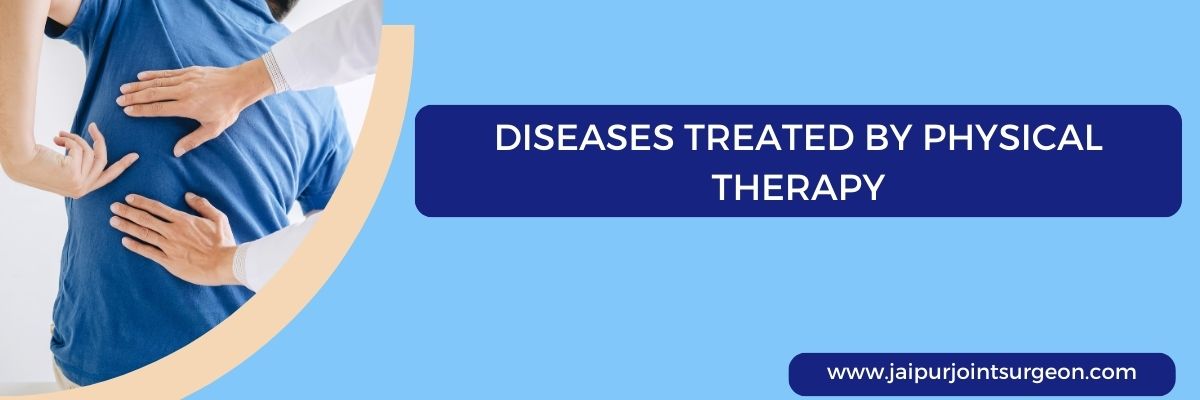Diseases Treated by Physical Therapy

Physical therapy has long been acknowledged for its rehabilitative advantages. It is a branch of healthcare that uses exercise regimes and specially designed equipment to treat various conditions and diseases and help improve physical function, mobility, flexibility, strength, and quality of life.
“Physical therapy is an integral part of treatment in your recovery from various musculoskeletal conditions,” says Dr. Dilip Mehta, an experienced orthopedic surgeon. “It helps you regain the range of movement and strength.”
Dr. Dilip Mehta is one of the most sought-after orthopedic surgeon in Jaipur for joint replacement surgeries, sports medicine, shoulder arthroscopy, arthritis, fractures, etc.
To speed up recovery, he often advises his patients to undergo physiotherapy in Jaipur.
Physical therapy overview
Image Source: https://www.inyourhometherapy.com/our-blog/types-physiotherapy-aware/
Physical therapy is provided by a licensed and trained physical therapist who curates a treatment regime to treat various health conditions, disabilities, and injuries after analyzing your condition.
Most people are unaware that there are different types of physical therapy, such as orthopedic, geriatric, pediatric, and neurological, to name a few. Each of them addresses different conditions and has different methods of treatment.
According to your condition and requirement, the therapist may include massage, joint mobilization, taping, traction, and exercise. The ultimate goal is to improve your condition and life quality.
Doctors can recommend physical therapy as a standalone option or supportive treatment. It can help in all phases of healing, from pain management to restorative to the preventive stage of recovery.
What are the advantages of physical therapy?
Image Source: https://seattleneuro.com/patient-education/physical-therapy/
Some of the benefits of physical therapy are:
- Reduces or eliminates pain
- Improves mobility
- May avoid surgery
- Helps recover from stroke, and sports injury
- Manages issues related to old age, such as osteoporotic or arthritic conditions
- Improves balance and prevents falls
- Manage chronic conditions
- Manage pulmonary problems
What are the diseases and conditions treated by physical therapy?
Below are some common medical conditions that can be treated by physical therapy.
Osteoporosis
Osteoporosis makes your bone brittle, weak, and prone to fracture. Physical therapy can help restore bone strength, movement, and function and prevent fractures.
Sports Injuries
Image Source: https://tribecacare.com/blog/sports-injury-common-problems-and-physio-solutions/
Physical therapy has a separate branch dedicated to sports injury, where they help injured athletes enhance their flexibility, strength, and stamina.
Joint replacement
Physical therapy is essential after surgery as the body loses its capacity to function normally. Physical therapy assists in pain management and helps regain range of motion and strength.
Back and neck pain
Image Source: https://pivotalmotion.physio/why-is-neck-pain-so-common-2/
Sitting for long hours, poor posture and age-related issues can cause back and neck pain. It can restrict your movement and hamper your daily activities. Physical therapy eases this pain to a great extent.
Ankle sprain
Twisting your ankle can cause ankle sprain, resulting in inflammation or torn or stretched ligaments. You can regain your ankle strength and minimize pain with a few physical therapy sessions.
Limited range of motion
Image Source: https://healthstarpt.com/physical-therapy-isnt-only-for-recovery-after-surgery/
This condition occurs due to repeated use of a specific part of your body resulting in swelling and tenderness. Physical therapy uses exercises to stimulate the healing of the particular joint and prevents further injury.
Carpel tunnel syndrome
Image Source: https://adventpt.com/treating-carpal-tunnel-with-physical-therapy/
Wrist injuries are quite common, especially among professionals. However, physical therapy offers evidence-based treatment options that enhance the flexibility of your wrists.
Muscular dystrophy
Due to various disorders and age, the muscles and bones weaken and gradually degenerate. Exercises help to minimize damage and regain more muscle strength and mobility.
Knee ligament injury
Image Source: https://www.physio.co.uk/what-we-treat/musculoskeletal/conditions/knee/knee-ligament-injury/medial-collateral-ligament-tear.php
Knee injuries can stretch and tear the ligaments. Treatment options include surgery and physical therapy. Dr. Dilip Mehta recommends physiotherapy in Jaipur to relieve pain, improve movement, and prevent permanent damage to the ligament.
Foot fracture
A fracture can occur due to injury or accident and cause a lot of pain. Physical therapy can help alleviate the pain and increase movement.
Huntington’s disease
Image Source: https://www.physio-pedia.com/Huntington_Disease
Huntington’s disease is characterized by voluntary and involuntary movements, which cause unsteady gait, spasms, and slurred speech. Physical therapy aims to correct the walking posture, build coordination and body control, and prevent falls.
Herniated disc
Image Source: https://runnerclick.com/herniated-disc/
A slipped disc is the displacement of the disc in your spine. This causes excruciating pain and restricted movement. Physical therapy assists in relieving the pressure on your spinal nerves and help strengthen the muscles that support the affected area.
Pelvic floor dysfunction
Pelvic floor dysfunction usually occurs in women where the pelvic bones and muscles get injured or damaged. It can be effectively treated by different types of exercise and correcting the posture.
Vertigo
Vertigo makes your head spin and causes dizziness, due to which you can lose your balance. Physiotherapy can help patients with vertigo improve their balance and control their bodies.
Consult Dr. Dilip Mehta, a leading orthopedic surgeon in Jaipur, if you face any issues with your musculoskeletal system and need accurate diagnosis and treatment. He practices at 3600 Knee Clinic.
